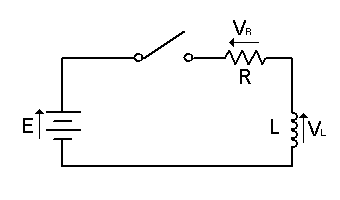
| Have you found an error or do you want to add more
information to these pages? You can contact me at the bottom of the home page. |

| The volt-drop across the inductor VL = L | di dt |
| So the supply voltage E = iR + L | di dt |
| E = iR + L | di dt |
| E - iR = L | di dt |
| E - iR L |
= | di dt |
now I will transpose this so di is on one side with the 'i' part and dt with L |
| 1 E - iR |
di = | dt L |
I can put integral signs on both |
| ∫ | 1 E - iR |
di = | ∫ | 1 L |
dt |
| Notice that | ∫ | 1 E - iR |
di is like | ∫ | 1 i |
di and the E - iR part is linear (a line). |
| u = E - iR so | du di |
= -R |
| re-arranging this means that - | du R |
= di |
| So, to find the solution to | ∫ | 1 E - iR |
di, we swap E-iR with u and di with - | du R |
| This gives us | ∫ | 1 u |
du -R |
which I can
re-arrange to put all the 'u' expressions on one side and the constants outside of the integral (to make it a bit easier) |
| - | 1 R |
∫ | 1 u |
du,
this is integrated to become: |
| ln(u) -R |
+ K, where K is just some constant. We can substitute back E - iR for u and get: |
| ln(E
- iR) -R |
+ K |
| ∫ | 1 E - iR |
di = | ∫ | 1 L |
dt |
| - | ln(E - iR) R |
+ K = | ∫ | 1 L |
dt, and we can find the second part to be |
| - | ln(E - iR) R |
= | t L |
+ K (this is the general solution) |
| - | ln(E - 0R) R |
= | 0 L |
+ K |
| - | ln(E) R |
= | K so we can put this back in to the general solution, in replacement for K |
| - | ln(E - iR) R |
= | t L |
- | ln(E) R |
| ln(E) R |
- | ln(E
- iR) R |
= | t L |
| 1 R |
ln | ( | E E - iR |
) | = | t L |
| ln | ( | E E - iR |
) | = | Rt L |
| i = | E |
( | 1 - e | - | Rt L | ) |
| R |
| Steady state current = | E | and the transient current = - e | - | Rt L |
| R |
| E - iR - L | di dt | = 0 |
| E - R•i(t) - L | d dt | i(t) = 0 |
| E s |
- Ls•i(s) -R•i(s) = 0 |
| E s |
= i(s)(Ls - R) |
| i(s) = | E s(Ls - R) |
| i(t) = | E |
( | 1 - e | - | Rt L | ) |
| R |
| Have you found an error or do you want to add more
information to these pages? You can contact me at the bottom of the home page. |